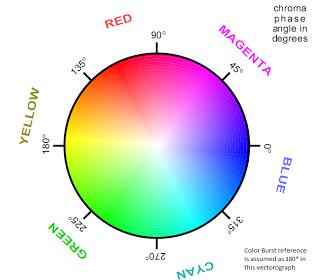NTSC composite video is a compatible standard. This means that video
signal works with older B&W TV Sets as well. So, we're looking to
understand how color information is added to the B&W NTSC signal in
such a way that Color TV sets can decode the color information while
older B&W TV sets ignore the color information. Developing such a
signal must have been a formidable task indeed !
The NTSC color standard achieves this by adding a color carrier to the
B&W signal. Adding a color carrier is simply superposing a sine-wave
onto the B&W signal. The first question that arises is how such a
superposition is not visible on B&W TV.
1. The carrier wave superposed is of significantly high frequency.
2. The phase of the wave is adjusted in such a manner than constructive
and destructive interference consecutively greatly reduces the
visibility of this artifact. Look for more details in the next part of
this series.
Now lets see exactly how we can convey color information to the TV using a superposed carrier.
The NTSC standard uses the following characteristics of the carrier wave to convey color info.
1. Amplitude of the carrier signal determines the color saturation at that point. ("Depth of Color")
2. Phase of the carrier with respect to a reference determines the hue at that point.
The reference wave is called the colour burst and is the short segment
of the wave ( 9-12 cycles ) sent during front porch that synchronizes
the TV's internal oscillator to the carrier we are sending.
This picture illustrates the process of interpretation of color.
In NTSC, the color carrier frequency is chosen to be 3.57954525Mhz and
the amplitude of the color burst is 20 IRE ( 140 IRE = 1 volt ). If
you'd like to know which phase corresponds to precisely which color
precisely, then refer to the NTSC vectorograph.
With this understanding of NTSC color encoding, we will soon be able to
generate NTSC color signal with digital hardware without having to use a
color encoding chip like AD725.
References
1. SX PONG - Rickard Gunee
2. AVR PAL Generation
3. AVR PAL Color Bar
4. Video Basics - Maxim
5. Lazarus-64 Project Documentation
6. AVRFreaks Forum Post by AtomicZombie
7. Atmega64 Game Console - Cedric Beaudoin
8. PAL Encoding using FPGA
9. NTSC Color Decoding



Very Nice!
ReplyDeleteThanks,
Learning how composite video works!
Tim